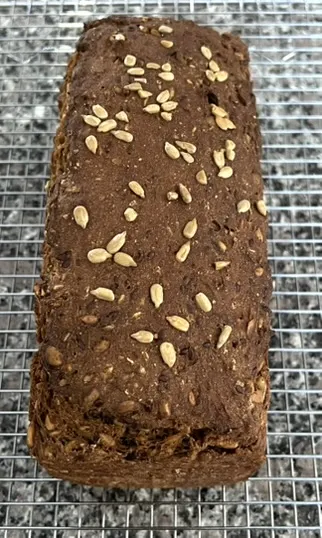
Here is yet another Danish Rugbrod for those who like rye bread. This recipe came from a website named makebread and is very simple.
Late one evening I mixed some sourdough starter (100 g), rye flour (300 g), pumpkin seeds (95 g), sunflower seeds (95 g), flaxseeds (50 g), molasses (40 g), and water (650 g) in a large bowl. Not knowing what to expect, I opted for a 4-quart Pyrex bowl with a lid, and that turned out to be a good choice, especially when adding the final dough ingredients.
Along with the sponge (listed above), I wanted to include some rye chops, and the recipe suggests letting them soak separately. I put some rye chops (130 g) into a small bowl, added boiling water (130 g), stirred the two until the rye chops were beginning to absorb the water, and then covered the bowl. Both the sponge and the soaker were left at room temperature overnight.
The next morning (about eight hours later) I removed the lid from the bowl containing the sponge. Into the bowl I added the soaker of rye chops as well as some rye flour (200 g), whole wheat flour (100 g), bread flour (50 g), and salt (21 g). The recipe states that the rye chops should be well-drained, and I found that the amount of water I used was just right and no draining was needed. A few minutes of stirring with a strong wooden spoon combined the ingredients into a mass that resembled thick porridge (as mentioned in the recipe), and I then put the lid back on the bowl.
The recipe suggests an hour or two for the fermentation, depending on the room temperature. Our kitchen was 67F, and I went for about two hours and twenty minutes before scraping the dough into a 9"x4"x4" Pullman pan that I had lined with parchment paper. My process was to take a chunk of the dough with a stiff spatula, drop the dough into the pan, and then press down to fill gaps before adding another chunk. This is really thick, really sticky dough. It will not pour. After smoothing the dough and sprinkling a few sunflower seeds on top, I lightly covered the pan and waited another hour.
Here is the dough at the start of the hour of proofing.
The first fifteen minutes of the bake is done at 395F, and after that the temperature is reduced to 355F. The recipe predicts another 60-90 minutes of baking time, but the real decider is the internal temperature of the loaf. Do not stop baking until that reaches at least 208F. For my loaf that took 100 minutes (after the initial fifteen).
The loaf developed a crack and lifted along one side (not shown in the photo) and came in at 1784 grams. Here is the loaf soon after emerging from the oven.
As with rye loaves in general, this one should sit for 24 hours before being sliced.
The bread is flavorful, and I am enjoying the sensation from finding one of the add-ins. My wife likes this bread too, and I am sure to bake it again.
Happy baking. Ted
- WatertownNewbie's Blog
- Log in or register to post comments
For anyone searching, the recipe is on makebread.com.au not on makebread.net.
Gary, thanks for adding that detail.
looks great ... mouth watering.
Rob
Thanks, Rob. It took me a while to branch out from mostly wheat breads to some that involve large amounts of rye, and I am glad that I did. The add-ins especially make this bread interesting.